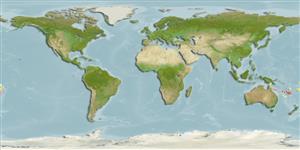Laticauda saintgironsi Cogger & Heatwole, 2005
Saint giron's sea krait| Native range | All suitable habitat | Point map | Year 2050 |

|
| This map was computer-generated and has not yet been reviewed. |
| Laticauda saintgironsi AquaMaps Data sources: GBIF OBIS |
Upload your photos
Google image |
No photo available for this species.No drawings available for Elapidae.
Google image |
No photo available for this species.
Classification / Names Common names | Synonyms | CoL | ITIS | WoRMS
Not assigned | Squamata | Elapidae
Environment: milieu / climate zone / depth range / distribution range Ecology
Reef-associated; depth range 0 - 60 m (Ref. 75803). Tropical
Distribution Countries | FAO areas | Ecosystems | Occurrences | Introductions
Indo-Pacific: Endemic to New Caledonia (Loyalty Islands).
Length at first maturity / Size / Weight / Age
Maturity: Lm ? range ? - ? cm Max length : 109 cm SVL male/unsexed; (Ref. 75804); common length : 90.0 cm SVL male/unsexed; (Ref. 2352)
Widely spread in tropical reefs. Spends half of its lifetime on land but goes back to water to hunt for food. It then returns to small islets to digest its prey, mate and lay its eggs. Hard-bottom forager, targeting anguilliform fishes in cavities and burrows. Occupies the same trophic level as Laticauda laticaudata (Ref. 101687). This species exhibits a more dynamic and complex predator-prey relationship with an anguilliform fish, its prey. Many conger or moray eels captured by sea kraits are likely to retaliate and bite sea kraits (considering krait versus prey body size), increasing the risk of injury on the sea krait's end as prey size increases, thus imposing difficulty on actual feeding (Ref. 118210).
Life cycle and mating behavior Maturity | Reproduction | Spawning | Eggs | Fecundity | Larvae
Main reference
References | Coordinator | Collaborators
Bisby, F.A., Y.R. Roskov, T.M. Orrell, D. Nicolson, L.E. Paglinawan, N. Bailly, P.M. Kirk, T. Bourgoin and J. van Hertum (eds.). 2008. (Ref. 75097)
IUCN Red List Status (Ref. 130435)
Least Concern (LC) ; Date assessed: 15 February 2009
CITES status (Ref. 108899)
Not Evaluated
CMS (Ref. 116361)
Not Evaluated
Threat to humans
Harmless
Human uses
| FishSource |
Tools
More information
Internet sources
BHL | BOLD Systems | CISTI | DiscoverLife | FAO(Publication : search) | Fishipedia | GenBank (genome, nucleotide) | GloBI | Gomexsi | Google Books | Google Scholar | Google | PubMed | Tree of Life | Wikipedia (Go, Search) | Zoological Record


